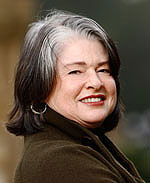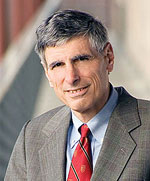April 21, 2009 - By Bruce Goldman

Laura Carstensen
Mortality: No matter who you are, where you've been, or what you've done, it's one topic that takes on more significance with every waking moment.
At a conference on campus April 15-16, leading experts from places as far-flung as Manitoba and Hong Kong assembled with Stanford faculty to address longevity-related issues from multiple perspectives. The third annual East-West Alliance Conference was co-hosted by the Stanford School of Medicine and the Stanford Center for Longevity. The School of Medicine is a member of the East-West Alliance, a global network of 10 universities receiving support from the Li Ka Shing Foundation.
Median life expectancy - the age to which one-half of a cohort of infants born in a given year can expect to reach or exceed - in the United States has risen from around 20 before the year 1800 to about 77 at the dawn of the 21st century, plenary speaker Laura Carstensen, PhD, director of the Center on Longevity, told the audience of some 60 people. 'People age 65 or over accounted for 4 percent of all U.S. residents in 1900. They account for 13 percent of the population now and, by 2030, will constitute 22 percent of the total,' she said.
'But the bulk of these increases have come about because fewer youngsters died by the age of 5,' Carstensen said. In contrast, the human life span - the longest amount of time any human being can hope to stay alive - hasn't changed at all. That limit is imposed not by the environment but by inner biological forces that are only now beginning to be understood.
Recent, near-miraculous advances in our understanding of biological processes at the cellular and molecular level offer the possibility of extending individual lives by slowing the aging process itself. A panel moderated by Stuart Kim, PhD, professor of developmental biology and of genetics, discussed the latest findings regarding genetic factors involved in longevity. Another, moderated by Tom Rando, MD, PhD, professor of neurology and neurological sciences and deputy director of the longevity center, focused on stem-cell-oriented approaches to achieving it.
'Those of us who do research on aging also experience aging,' Kim remarked wryly, by way of underlining the enthusiasm with which the hunt for genetic factors responsible for aging is being joined. While environment plays a huge role in sustaining or destroying health, evidence is building that there's also a clear genetic component. Anne Brunet, PhD, assistant professor of genetics, reported that in a tiny worm called C. elegans, a mutation in a single gene not only substantially increases the worm's life span, but also correspondingly extends the period during which that worm shows the visual and behavioral earmarks of youthful vitality. An analogous gene exists in fruit flies and mice as well as in humans.
Not that environment doesn't play a key role in aging-associated disease. For instance, the gene cited by Brunet is involved in the insulin pathway. Brunet, whose laboratory is studying aspects of this pathway in mammals as well as in C. elegans, noted that restricting caloric intake by about one-quarter to one-third - which suppresses insulin levels - has a life-span-increasing effect on all other species in which it's been tried: worms, flies, mice, even monkeys. Experiments with humans are ongoing, but our life spans are so long that data are dribbling out slowly. However, an apparent diminution in aging-related conditions such as type-2 diabetes, stroke and cancer is being seen, she said.
Most cells in our body have limited capacities to replicate themselves faithfully, so our tissues eventually wear out, noted Rando. But stem cells can undergo a large number of successful cell divisions as well as differentiate into cells in the tissues they inhabit. These special cells are becoming shown to populate an expanding set of tissues - even the brain, which until 15 years ago was believed to have no self-regenerating capability at all.

Philip Pizzo
Medical school Dean Philip Pizzo, MD, asked: 'With all the current attention to regenerative medicine involving surgical stem-cell implantation, is an equal emphasis being placed on altering stem-cells' microenvironment? That may be where the low-hanging fruit is.'
Panelist Tony Wyss-Coray, PhD, associate professor of neurology and neurological sciences, concurred, saying that he and his colleagues have identified hundreds of blood-borne factors that either inhibit or encourage stem-cell proliferation in the brain. They have shown in mice that with advancing age the ratio of these circulating factors increasingly favors inhibition. Rather than try to replace worn-out or depleted stem-cell populations in the brain with new ones, the Wyss-Coray lab is looking for ways to supply the ones that are there with factors that 'wake them up,' or, conversely, by removing other factors that inhibit their proliferation.
Another panel moderator, economics professor John Shoven, PhD, presented a solution for our increasing Social Security shortfall: indexing 'age inflation' the way we do with the cost of living. 'Maybe a 65-year-old now is really not the same as in 1970, just as a dollar now isn't the same as a dollar in 1970,' said Shoven. A 65-year-old man today has the same risk of dying as a 59-year-old did then, he said, adding, 'Disability-free life expectancy is rising at least as fast as life expectancy. The average length of retirement in the United States went from two years in 1900 to 20 years in 2000.' Shoven concluded that we probably could work a bit longer before we start collecting Social Security.
About Stanford Medicine
Stanford Medicine is an integrated academic health system comprising the Stanford School of Medicine and adult and pediatric health care delivery systems. Together, they harness the full potential of biomedicine through collaborative research, education and clinical care for patients. For more information, please visit med.stanford.edu.